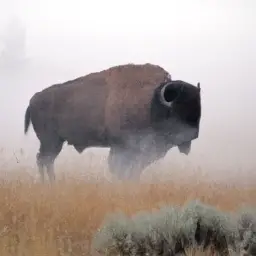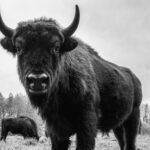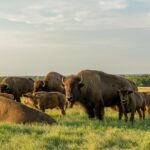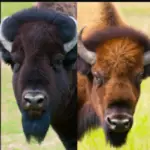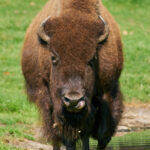Overview of Bison Mating Season
Typical mating season timeline
The bison mating season typically occurs during the late summer and early fall months, although the exact timing can vary depending on environmental factors such as geographical location and climate. It is generally a short and intense period, lasting around 4-6 weeks. During this time, the majority of mating and fertilization takes place, setting the stage for the birth of calves in the following spring.
Factors influencing mating season
Several factors influence the timing of the bison mating season. One of the primary factors is the availability of food. Bison prefer to mate when food sources are plentiful, ensuring the availability of nutrients for both the pregnant females and their offspring. Additionally, environmental cues such as day length and temperature can also play a role in triggering the mating season.
Understanding Bison Mate Selection
Behavioral characteristics of males during the rut
During the mating season, also known as the rut, male bison exhibit distinctive behavioral characteristics. They become more territorial and engage in aggressive displays to establish dominance. These displays involve head butting, wallowing in mud, and marking their territory with scent glands. The strongest males, known as dominant bulls, engage in fierce competition for the attention of females.
Role of females in mate selection
Contrary to popular belief, it is actually the female bison who have the final say in mate selection. They assess the physical fitness of potential mates based on various factors such as size, strength, and health. This selection process ensures that the calves produced from these unions have the best chances of survival. The females also play an active role in initiating copulation, signaling their readiness to mate through specific behaviors.
Climatic Impact on Mating Season
Impact of seasonal weather changes
Seasonal weather changes, such as temperature fluctuations and precipitation patterns, can have a significant impact on the bison mating season. Cold and harsh conditions during the winter months may delay or disrupt the onset of the rut, as bison conserve energy for survival rather than reproduction. Conversely, milder weather conditions in the early fall can accelerate the start of the mating season, allowing for optimal breeding opportunities.
Global warming and its implications on bison mating
With the increasing threat of global warming, the bison mating season faces potential disruption. Rising temperatures and unpredictable weather patterns may affect the timing of the rut and disrupt the synchronization between male and female bison. Shifts in the availability and distribution of food sources can also affect the health and reproductive success of bison populations, ultimately impacting their mating behavior.
Signs of the Bison Mating Season
Physical changes in the bison
During the mating season, male bison undergo physical changes that reflect their heightened state of readiness for mating. Their necks thicken, and a prominent hump develops on their shoulders due to increased muscle mass. Additionally, male bison emit a distinctive musky odor, produced by glandular secretions, to attract females and assert their dominance.
Changes in herd behavior
The beginning of the bison mating season is marked by shifts in herd behavior. Male bison become more aggressive and engage in fierce battles to establish dominance within the herd. Female bison become more elusive and selective, actively avoiding the advances of weaker or less desirable males. These behavioral changes within the herd indicate the commencement of the mating season and set the stage for the subsequent reproductive activities.
Aggressive Mating Tactics
Competitive behavior among male bison
Male bison employ various aggressive mating tactics to gain access to females. They engage in intense battles, bellowing loudly and locking horns to establish a hierarchy within the herd.
The dominant bulls, having successfully asserted their dominance, have the privilege of mating with multiple females, while the subordinate males are often left without any mating opportunities. This competition for mating rights ensures the selection of the fittest individuals for reproduction.
Defensive strategies of female bison
Female bison have evolved defensive strategies to protect themselves during the mating season. When pursued by overly aggressive males, they exhibit evasive maneuvers and selective mate choice.
By actively avoiding weaker males and choosing dominant and healthy partners, female bison increases the likelihood of producing healthy offspring. These defensive tactics are vital in maintaining the genetic diversity and overall fitness of the bison population.
Geographical Variations in Mating Seasons
Differences in mating seasons across habitats
The timing of the bison mating season can vary across different habitats and geographical regions. Bison populations living in more southerly latitudes often have earlier mating seasons due to milder climates and an abundance of food resources.
Conversely, bison populations inhabiting northern regions generally experience a delayed mating season due to harsher weather conditions and limited food availability during the winter months.
Impact of altitude and latitude on bison mating
Altitude and latitude also play a role in determining the timing of the bison mating season. Higher altitudes and latitudes generally experience colder climates and shorter growing seasons, which can delay the onset of the rut. These geographical factors influence the availability of food and the overall fitness of bison populations, ultimately shaping the timing and dynamics of their mating behavior.
Impact of Bison Mating Season on Local Ecosystem
Seeding and landscape alterations due to bison movement
The bison mating season has various impacts on the local ecosystem. As male bison engage in territorial displays and compete for mates, their movements can lead to the redistribution of seeds from different plant species.
This process, known as seeding, contributes to the dispersal and germination of seeds, promoting plant diversity and ecological succession.
Additionally, the wallowing behavior of male bison during the rut can alter the landscape by creating wallow pits and trampling vegetation.
Effect of bison mating season on local flora and fauna
The bison mating season also has indirect effects on local flora and fauna. The increased movement of bison herds in search of mates and suitable breeding grounds can create disturbances within the ecosystem.
This disturbance can benefit some species by creating new habitat niches, enhancing nutrient cycling, and promoting plant growth. However, it can also have negative impacts on sensitive species, especially if the disturbance is prolonged or excessive.
Human Interaction During Bison Mating Season
Safety measures for humans
Interactions between humans and bison during the mating season require caution and adherence to safety measures. It is essential to maintain a safe distance from bison herds and avoid any aggressive or provocative behavior that may trigger defensive responses.
Visitors to bison habitats should follow park regulations, stay on designated paths, and respect the wild nature of these animals. Educating the public about proper behavior around bison can help prevent potential conflicts and promote safety for both humans and bison.
Impact of human presence on bison mating behavior
Human presence during the bison mating season can have unintended consequences on their behavior. The disturbance caused by human activities, such as loud noises, close proximity, or uncontrolled pets, can disrupt the natural mating behaviors of bison.
This interference can result in altered movement patterns, stress, and potential injury to both humans and bison. It is crucial for humans to minimize their impact and allow bison to engage in their natural mating behaviors undisturbed.
Bison Mating and Reproduction
Process of fertilization
During copulation, male bison mount females from behind and insert their penis into the female’s vagina. This position allows for the successful fertilization of the eggs.
Bison have a unique reproductive strategy called delayed implantation, where the fertilized egg is not immediately implanted into the uterus. Instead, it remains in a state of dormancy for several months until optimal conditions are met for successful gestation.
Gestation period and birth
The gestation period of bison is approximately 9 months, similar to that of cattle. After the dormant period, the fertilized egg implants into the female’s uterus, commencing the development of the fetus.
The birth of bison calves usually occurs in the spring, with females giving birth to a single calf after a relatively short labor. The newborn calves quickly gain strength and mobility, joining the rest of the herd within the first few hours of life.
How Does the Mating Season Affect the Social Structure of American Buffalo Herds?
During the mating season, the social structure of American buffalo herds experiences notable changes. Dominant males engage in fierce competitions for mating rights, often leading to shifts in hierarchy. This impacts the herd’s dynamics as subordinate males may form bachelor groups or challenge the dominants. Ultimately, the mating season has a significant influence on the social structure of american bison herds.
Conservation and Management During Mating Season
Role of national parks and reserves
National parks and reserves play a crucial role in the conservation and management of bison populations during the mating season.
These protected areas provide suitable habitats and protection for bison to engage in their natural mating behaviors without disturbance from human activities.
Park management practices, such as controlled access, monitoring, and habitat restoration, ensure the long-term viability and genetic diversity of bison populations.
Efforts towards protecting bison during mating season
Conservation organizations and researchers are actively involved in efforts to protect bison during the mating season. They conduct studies to better understand the impact of environmental changes on bison reproduction, monitor population health, and develop conservation strategies tailored to specific regions and habitats.
These efforts involve collaborative partnerships with local communities, government agencies, and stakeholders to promote the sustainable management of bison populations and their mating behaviors.
In conclusion, understanding the intricacies of bison mate selection and the dynamics of the mating season is essential for the conservation and management of these iconic animals.
Knowing the behavioral characteristics of male and female bison, the influence of climatic factors, and the impact of human interaction allows us to appreciate and protect these magnificent creatures during this crucial period of their lives.
Through ongoing research, education, and conservation efforts, we can ensure the preservation of bison populations and their integral role in maintaining the biodiversity of our ecosystems.

